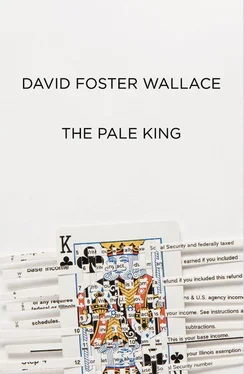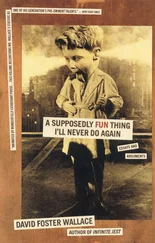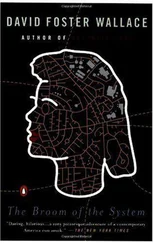In short, it all seemed like just phenomenally bad planning, resulting in gross inefficiency, waste, and frustration for everyone involved. 31Three obvious remedies presented themselves, which were sketched in outline form in my notebook, although whether I jotted them down right there in situ during the maddening Sisyphean so-near-and-yet-far stasis or entered them later that day — during which there were plenty of additional stretches of downtime with nothing to do except read the vapid book I’d already begun mordantly annotating on the bus ride — I will not pretend to recall. One remedy would be to institute some form of reserved parking, which would eliminate a good deal of the backup and clot resulting from people trolling for available spaces in the lots, as well as the ‘incentive’ problem of employee vehicles all beelining for the most desirable two or three lots near the REC’s central entrance (which of course we hadn’t yet seen from Self-Storage Parkway; the entrance’s location was deduced from the apparent desirability of the parking lots behind [from our perspective] the building, given the number of cars heading for it, which was clearly linked to some form of tangible incentive. The employee beside me now looked, peripherally, as though he’d been mechanically raised out of a body of water, which made the pretense of my not noticing the incredible sweating even more creepy and farcical). Another anodyne would obviously be to widen the access road and make it two-way. Admittedly, this could expose the REC to some additional short-term inconvenience and snarl along the same general lines as the widening of Self-Storage Parkway, although it was difficult to envision the widening of the access road taking anywhere near as long, since it wouldn’t be subject to the delays and conflicting agendas of the democratic process. The third remedy would be to sacrifice, for the greater good and convenience of everyone except perhaps the REC’s landscaping contractor, the virid expanse of the empty front (i.e., what turned out to be the rear) lawn, and to place on it not only a paved walkway but maybe an actual transverse spur that would allow vehicles on the EXIT portion of the road to cross back over to the ENTRANCE portion without having to make lightless left turns both onto and off the jammed parkway. Not to mention of course simply placing some goddamn traffic lights at the two intersections, which it was next to impossible to imagine the Internal Revenue Service not having enough suction with the municipal and state authorities to be able to demand just about any time it pleased. 32Not to mention the sheer strangeness of having it be (it emerged) the REC’s mammoth rear facing Peoria’s main orbital road. It seemed, on slow approach, both craven and arrogant, like pre-modern priests who faced away from the communicants during Catholic mass. Everything from logistics to elementary civics would seem to dictate that a major government facility’s front should face the public it serves. (Recall that I had not yet seen the REC’s stylized front facade, which was identical to those of the nation’s other six RECs, and had been installed after an uncaught typo in the enlarged construction and technology budget after the King Commission IRS reforms had been permitted to pass into law, that typo mandating that Regional Service and Examination Centers’ facades’ ‘form specifications’ rather than ‘form al specifications’ be ‘… matched as closely as possible to the specific services the centers perform.’ 33)
As to our actual physical arrival at the center’s main entrance on that first day, all I can say by way of summary is that there is an indescribable thrill about seeing one’s own printed name on a sign held up at a crowded place of disembarkation. I suppose part of it is that one feels especially picked out and — to use the bureaucratic term — validated. The special sign with my name on it held aloft by an attractive, official-looking woman in a bright-blue blazer was also, obviously, after all the ignominies and demeaning hassles, and consequent lateness, surprising, though not so surprising that any person could be reasonably expected to have seen it as immediate evidence of some error or confusion — there was, after all, the aforementioned matter of nepotistic juice and the letter in my dispatch case.
This was also when it emerged that the REC’s ostensible rear was really the front, and that the two orthogonal parts of the center were not continuous, and that the main building’s facade was stylized in a strange and kind of intimidating way that one would concede it was maybe prudent to keep from facing, or looming over, the crowded public road just south. Even without the crowding and chaos, the whole huge main-entrance area was complex and disorienting. There were flags, coded signs, directional arrows, and a kind of broad concrete plaza with what looked to have been a fountain but had no water spurting. 34The main building’s square shadow extended almost all the way across the plaza to the two highly desirable parking lots opposite, neither of which was all that large. And there was the REC’s elaborate and obviously expensive facade, which extended from just above the main entrance to the middle of what appeared to be the fifth floor; it was some kind of tile or mosaic representation of a blank IRS 1978 Form 1040, both pages of it, complete in all detail down to verso Line 31’s slot for the computation of ‘Adjusted Gross Income’and recto Line 66’s terminal ‘BALANCE DUE’box, which box served, along with the form’s myriad other slots and boxes and inset squares, as what looked to be windows. The detail was striking and the cream, salmon, and celadon of the offset colors realistic, if slightly dated. 35Also, to make the whole thing even more overwhelming/disorienting when seen all at once from the circular spur off the access road whence Service vehicles could pull right up and offload their passengers without having to park (which would have necessitated going all the way back out and around again, since the parking lots just opposite the entrance, across the plaza, were completely full and even had some extra vehicles parked in prohibited corner spaces that would keep other vehicles from being able to back out of their spaces and exit), the giant 1040, which was realistically proportioned to scale and so was slightly longer than it was wide, was flanked at either distant end by a large, round inset intaglio or glyph of some kind of chimerical combat and a Latin phrase, indecipherable in the right-hand side’s deep shadow, which turned out to be the Service’s official seal and motto (none of which I had been told in my contractual materials [which, as mentioned, tended to be both cryptic and tonally stern or urgent, really little more than engines of apprehension as far as I’d been concerned, sitting in my family’s unused parlor and trying to parse them]). By way of one more detail, the whole elaborate facade assembly was reflected — though in an angled and laterally foreshortened way that made the edge’s glyph and motto look closer together than they actually were — by the garishly mirrored exterior side of the REC’s other structure, a.k.a. the ‘REC Annex,’ which lay at almost a perfect right angle to the main facade and was connected at two floors to the main building’s west edge by what then appeared to be large green tubes supported by blinding (since not in the main building’s shadow) forests of slender anodized or stainless steel poles, which metal supports looked strange and millipedic from this angle and were further reflected in blinding little angled slices by the edges of the Annex’s mirrored exterior.
One or two of the mirrored panels were broken or cracked, however, I remember noting. 36
Читать дальше












